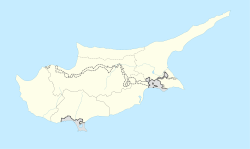
Back شويروكويتا Arabic Xirokitiya Azerbaijani Хирокития Bulgarian Khirokitia Catalan Choirokoitía (arkiyolohiyang dapit) CEB Choirokoitia Czech Chirokitia German Χοιροκοιτία Greek Khirokitia Spanish Khirokitia Basque
Χοιροκοιτία, Chœrocœtía | |
 View of Khirokitia | |
| Alternative name | Choirokoitia |
|---|---|
| Location | Larnaca District, Cyprus |
| Coordinates | 34°47′48.21″N 33°20′37.39″E / 34.7967250°N 33.3437194°E |
| Management | Cyprus Department of Antiquities |
| Official name | Choirokoitia |
| Type | Cultural |
| Criteria | ii, iii, iv |
| Designated | 1998 (22ns session), modified 2012 |
| Reference no. | 848bis |
| Region | Europe and North America |
Khirokitia (sometimes spelled Choirokoitia; Greek: Χοιροκοιτία [çiɾociˈti.a], suggested meaning Pig-cradle, from χοίρος 'pig, boar' + κοιτίς 'place of origin, cradle') is an archaeological site on the island of Cyprus dating from the Neolithic age. It has been listed as a World Heritage Site by UNESCO since 1998.[1] The site is known as one of the most important and best preserved prehistoric sites of the eastern Mediterranean. Much of its importance lies in the evidence of an organised functional society in the form of a collective settlement, with surrounding fortifications for communal protection. The Neolithic aceramic period is represented by this settlement and around 20 other similar settlements spread throughout the island.[2]
- ^ "Choirokoitia". UNESCO World Heritage Centre. Retrieved 9 April 2021.
- ^ "History Of Architecture". History World. Retrieved 23 June 2017.
